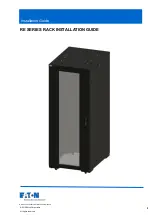
Installing Battery Cabinets
3-13
EATON
Powerware
®
9390 Integrated Battery Cabinet (Models IBC-S and IBC-L) Installation Manual
S
164201536 Rev D
www.eaton.com/powerquality
9.
Locate the UPS-to-battery cabinet breaker sensing cable inside the first battery
cabinet. Mate the connector on this cable with the matching connector in the
cabinet (see Drawing 164201536-8 on page A-17). Route the other end of this
cable through conduit (top or bottom entry) to UPS cabinet and connect to
terminal strip TB2. Refer to the appropriate Powerware 9390 UPS Installation and
Operation Manual, as referenced in paragraph 1.6, for UPS cabinet terminal
locations.
10.
Use pressure and bus bar terminations, as necessary, for connecting cables
between the UPS and battery cabinet. Connect and route cables from positive (+)
and negative (–) terminals in the first battery cabinet through conduit (top or
bottom entry) to UPS cabinet terminals E4 and E5.
11.
Verify that all battery breakers are in the OFF position.
12.
Connect the string of battery trays by mating the loose red connector from each
tray to the fixed black connector mounted on the front edge of the tray above.
Connect the top and bottom tray connectors to the mating cabinet connectors to
complete the battery string connections (see Figure 3‐6).
13.
Repeat Step 11 for each battery cabinet, and then proceed to Step 14.
14.
Replace the doors that were removed in paragraph 3.2.
15.
Secure all battery cabinets by closing and latching the doors.
16.
Once the battery cabinets are installed and wired, return to the appropriate
Powerware 9390 UPS Installation and Operation Manual, as referenced in
paragraph 1.6, to complete the UPS wiring.
3.4 Model IBC-L Battery Cabinet Installation
The method used to install the battery cabinets depends on the type of installation being
undertaken.
Each battery cabinet can be installed as a line-up-and-match or standalone system. The
term
line-up-and-match
refers to battery cabinets that are physically attached to the UPS,
share internal wiring, and use the battery cabinet breaker as the battery isolation device.
The term
standalone
refers to battery cabinets that are not physically attached to the UPS,
are wired with external contractor-supplied wiring, and use a single overcurrent protection
and disconnect device located near the batteries.
A
To install an line-up-and-match battery system, proceed to paragraph 3.4.1.
A
To install a standalone battery system, proceed to paragraph 3.4.3.
















































